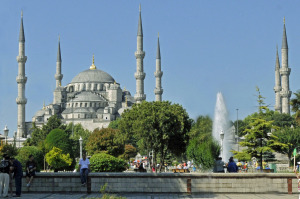Ahmed I became Sultan of the Ottoman Empire in 1603, at age 13. After a series of military setbacks, Ahmed sought God’s favor by building a mosque in Istanbul to rival the one built in 1558 by Suleiman the Magnificent, his much more successful predecessor. Like Suleiman, Ahmed modeled his mosque on Hagia Sophia, built as a church by Byzantine Emperor Justinian in 537 A.D. and later converted to a mosque by adding a mihrab in the direction of Mecca and minarets. Ahmed’s architects lacked the skill (or courage) of those of Justinian, who imaginatively supported the massive dome of Hagia Sophia on its exterior walls. The smaller dome of Ahmed’s mosque is supported on four interior columns derided as “elephant legs.” Light from more than 200 stained glass windows is supplemented by ornate chandeliers holding uncooked ostrich eggs intended to repel spiders and prevent unsightly webs.
Ahmed surrounded his mosque with six needle-shaped minarets carrying a total of sixteen balconies honoring him as the 16th sultan. When Islamic authorities in Mecca learned of the minarets, two more than around both Hagia Sophia and Suleiman’s mosque, they were outraged. The Great Mosque in Mecca had six minarets and, as the holiest place in Islam, was not to be out ranked in the minaret department. Ahmed reportedly solved the problem by financing the construction of a seventh minaret in Mecca.
Ahmed died at age 27, a year after completion of his mosque, and was interred in a mausoleum just outside the walls. Although his mosque is officially known as the “Sultan Ahmed Mosque,” it is popularly known as the “Blue Mosque” because of 20,000 handmade blue and white tiles in fifty different designs adorning its interior. Still used by Muslim worshippers, the Blue Mosque is open to the public except during daily prayers. Visitors can see for themselves if the ostrich eggs really work.

Comments are closed.